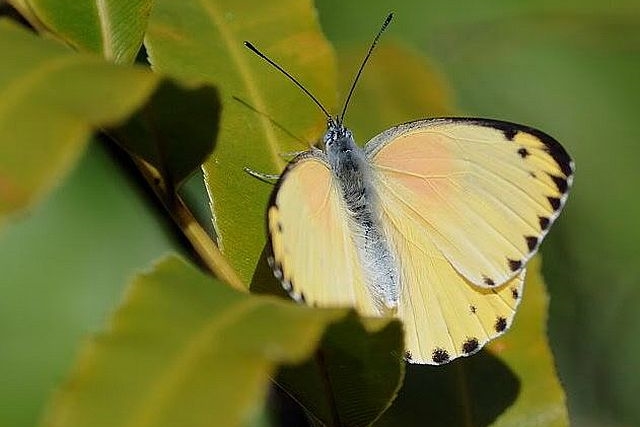Scarlet Tip Colotis annae annae (formerly:
Colotis danae annae)
Family: Pieridae. Subfamily: Pierinae. Tribe: Pierini

- Scarlet Tip.jpg (274.16 KiB) Viewed 2455 times
Dry season form, male, Marloth Park, Mpumalanga, July 2020 © Richprins
Description
Wingspan: 35–55 mm. Variation in size of seasonal forms. Sexually and sesonally dimorphic.
In all males the upperside forewing tips are broad brilliant red. Underside of both sexes, all forms, has a dical row of brown-centered black spots on both wings.
Male wet season form: Upperside has broad black hinwing margins and basal edge to red forewing tip.
Female wet season form: Upperside ground colour white with very heavy black basal patches, discal spotting and marginal borders, sometimes appearing marbled. Forewing apical tip either a red patch crossed with black spots, or black with a series of pale salmon-pink or buff spots.
The dry season form has much less darker markings in both sexes. The male has lost the darker edge. In the female's winter form the darker markings are lighter and less heavily pronounced. The underside markings are pale dusted colour (assisting with camouflage).
Slow wandering flight close to the ground. Fond of flowers. Usually stays near foodplants.
Distribution
Zambia, Mozambique, Zimbabwe, Botswana, Namibia, South Africa (Limpopo Province, Mpumalanga, North West Province, Gauteng, KwaZulu-Natal,
Eastern Cape Province), Eswatini.
Habitat
Open to wooded savanna. Hillsides, flatlands, forest edges.
Biology
Flight period: All year; most abundant in late summer and autumn (nominate ssp.). There are distinct seasonal forms of the nominate subspecies. Wet season form: October to March. Dry season form: Ferbruary to November.
Larval foodplants:
Cadaba natalensis, Cadaba species,
Cadaba termitaria, Capparis species,
Maerua angolensis, Maerua rosmarinoides.
Links:
http://www.metamorphosis.org.za/article ... educed.pdf




 © Blu'Tuna
© Blu'Tuna © Pumbaa
© Pumbaa © Pumbaa
© Pumbaa © Dewi
© Dewi © nan
© nan